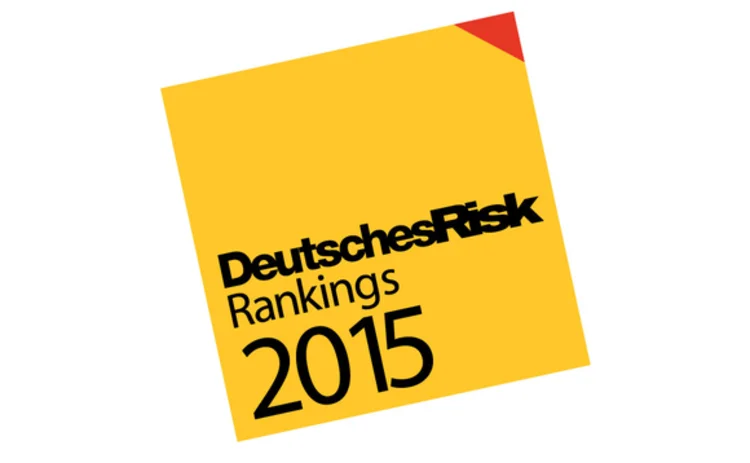
Deutsches Risk Rankings 2015
The return of volatility, coupled with regulatory change, has challenged the titans of the German market, allowing foreign competitors to muscle in.

European financial markets have endured a white-knuckle ride this year, forcing dealers across the continent to up their game when it comes to providing tailored derivatives solutions to end-users. Germany has been no exception.
Quantitative easing (QE) by the European Central Bank has had the desired effect on equity indexes across the continent. The Dax index surged more than 2,600 points from January to April, and the EuroStoxx 50 by more than 350 points. Yet events have conspired to frustrate policy-makers, as jitters over the status of Greece in the eurozone throughout June and July, and the impact of a faltering Chinese economy in August, wiped out many of these gains.
Foreign exchange markets have been no stranger to volatility either. The euro has bounced between a high of 1.20 and a low of 1.04 against the dollar since January as markets have reacted to the decoupling of macroeconomic policy between the US and the eurozone, and ongoing political turmoil in the single market. The Swiss franc/euro pair has also been a focus since the Swiss National Bank’s decision to remove the 1.20 ceiling on its trading price on January 15.
In this rough-and-tumble environment, financial institutions and corporates need banks that are able to provide a consistent level of service and provide liquidity through choppy markets.
“Last year, the question was: when is volatility ever going to come back? This year it is when is volatility ever going to stop? These conditions, combined with the regulatory environment, have put a different price tag on liquidity and how banks price their resources,” says Nikolaus Giesbert, head of fixed income and currencies at Commerzbank, which topped this year’s Deutsches Risk rankings for the second year in a row.
The Frankfurt-based outfit also swept the interest rates, currencies and risk management categories, as well as polling strongly in the four equity products categories. UniCredit polled second for overall house, pushing Deutsche Bank into third place for the first time in the rankings’ history.
Commerzbank’s Giesbert attributes his bank’s success to two factors: astute risk management and a strong focus on advisory services. Despite difficult conditions at the start of the year, the group doubled its operating profit in the first quarter of 2015 compared with the same period in 2014. Commerzbank also continues to help clients navigate the labyrinthine regulatory environment out of its markets services unit: educating institutions on the European Markets Infrastructure Regulation’s rules on central clearing in particular.
Continued uncertainty on precisely when the various clearing obligations will come into force – and whether mooted carve-outs for specific client types will apply – have complicated firms’ journey to compliance this year. Dealers are grappling with the question of whether or not a credit valuation adjustment (CVA) amnesty allowed under the Capital Requirements Regulation applies to the swaps they have struck with pension funds after Risk.net learned a clearing exemption applicable to pension funds had expired weeks before a new extension could be granted.
Corporates, too, are in limbo over whether an exemption from having to clear over-the-counter derivatives and collateralise uncleared trades conducted for hedging purposes will remain in force following the publication of a review of the framework by the European Securities and Markets Authority (Esma) in August. It all adds up to a more heterogeneous derivatives marketplace.
“What is challenging these days is that corporates are faced with a wide range of prices for the same products from different banks, as a result of different trade portfolios and how banks manage their CVA, liquidity charges and other regulatory costs. The client has to be kept informed that the pricing process is much more complex than it was in the past,” says Marc Reichel, head of rates sales for corporate clients at HSBC, which polled sixth in this year’s rankings — up three spots on 2014.
Competitive pressures
Variations in pricing may frustrate end-users, but it opens the door for canny dealers to carve out a niche for themselves and grab market share from the established banks. Three of this year’s top 10 are new entrants for 2015, while two new names feature in the interest rates top five and three in the currency category.
HSBC is one example of a foreign dealer that has expanded its footprint in Germany over the last year. “We have been growing our presence on the corporate side in Germany, especially in the regions beyond the main centres of Dusseldorf and Frankfurt, bringing our global expertise to corporates that need solutions for volatile and emerging markets, such as China,” says Reichel.
Bank of America Merrill Lynch (BAML) is another overseas player that has shot up the rankings, largely for its excellent showing in the foreign exchange categories. The US dealer polled first in forex options, and entered the top 10 overall rankings for the first time.
The bank’s success is the result of a concerted push to broaden its coverage in the region – particularly with heavyweight asset managers and corporates, says Vanessa Holtz, global head of Group of 10 (G-10) forex option trading, vanilla and electronic, at BAML in London.
“It is easy to provide quality service for the Group of Five (G-5) currency pairs, but what sets us apart is our ability to provide liquidity for non-standard currency pairs. Our German asset management clients have been very interested in accessing that liquidity,” she adds.
Holtz explains that BAML’s liquidity profile is a function of how the forex division runs its book. G-10 forex options positions are matched with negatively correlating trades out of a single portfolio, allowing the bank’s traders to tap internal cross rates and pass the savings onto the end-client. “This dramatically reduces our costs, minimises the amount we have to dip into the market to hedge our own exposures, and increases our capacity to warehouse risk,” she says.
Regulation is also encouraging corporates and institutions to diversify their roster of counterparties. For example, the Markets in Financial Instruments Directive (Mifid II) is supposed to encourage more transparency and competition in financial markets by pushing trades towards exchanges and incentivising best-execution policies based on price, rather than the pre-existing bilateral relationships between banks and clients. As part of the incoming directive, OTC product classes that are classified as liquid by Esma will have to abide by new pre- and post-trade transparency rules – including making the current bid-offer spread public before a transaction is executed.
“This obligates local dealers to shop around the larger investment banks for better pricing. They will no longer be bound to stay with a historical ‘parent bank’,” says one European-based forex executive at a major investment bank.
Established dealers underplay the significance of this levelling of the playing field. Giesbert at Commerzbank believes that – while the confluence of regulatory regimes will afford more opportunities for foreign banks to deploy resources in specific asset classes, as BAML has done with its forex offering in Germany – the dominance of local players is unlikely to diminish. Regulatory harmonisation will also allow Commerzbank to further penetrate overseas markets, he adds.
Capital pressures mean that banks, no matter their home domicile, will have to pick and choose more selectively when it comes to building their deal book. “As the sell side is shrinking in balance sheet and coverage capacity, banks are becoming more strategic about which clients they choose to cover. The oversupply in years past means that quality of service is now even more important as a differentiator between investment banks. For us, it has been important to keep the right personnel on board, in order to provide clients with strong content and broad coverage,” says Daniel Wrobel, co-head of distribution for Germany and Austria at Barclays, which slots in at seventh place in this year’s rankings.
New horizons
Opportunities for expansion for both foreign and local players fall into two buckets: servicing insurance clients seeking capital efficiency under incoming Solvency II regulation, and providing dynamic hedging solutions to institutions that are wise to the shortcomings of static derivative overlays in the newly volatile market environment.
Insurance clients have been keeping the equity derivatives desk at UBS busy this year. “We’ve had interesting discussions recently with an insurance firm seeking straightforward plain vanilla solutions to provide capital relief – such as downside puts. However, the appetite for more sophisticated solutions as a way of getting cheaper protection is only at the discussion stage,” says Andres Schmitz, equity derivative sales at UBS.
Other insurers UBS has courted over the past few months say it is “too early” for structured equity solutions to be implemented for two reasons, says Schmitz. First, because of a desire from firms to go after the low-hanging fruit in terms of capital relief, and second because some solutions require more analysis to assess their effectiveness under regulations. Yet he is optimistic that interest will increase in the months ahead: “We think regulatory certainty through Solvency II will make firms more confident to invest in equity instruments. We are well-positioned as the biggest foreign issuer in Germany – we just hope the European recovery continues,” says Schmitz.
Asset managers offer more fertile ground for structured solutions in the interim. Schmitz says he has witnessed a lot of interest from euro-based institutions hungry for quanto-hedged exposure to Japanese equities in order to tap the gains made possible through so-called ‘Abenomics’ – the government’s massive programme of monetary stimulus. The bank’s efforts saw it place third in the equity products category.
Meanwhile, corporates are increasingly looking for hedge overlays that are able to adjust with the market environment. Static hedges with inflexible terms – like forward contracts – are still being used, but corporates are also keen to widen their product mix due to the shortcomings of these instruments. “We see demand to increase the ratio of hedges and also dynamic strategies, especially in highly volatile markets where traditional hedging strategies either entail a higher cost, through interest rate differentials or if entered into at a wrong time could result in significant negative mark-to-market,” says Holger Zeuner, head of the corporate solutions group at HSBC.
This is especially true when it comes to foreign exchange, he adds, as big currency swings impact on corporate’s value-at-risk targets. The volatility of the Chinese renminbi in August is a case in point. Its fall versus the euro threatens the bottom line of German exporters, driving a demand for structured hedge solutions.
Structured products
Looking towards next year, a catalogue of regulatory changes promises to shake up a structured products market already reeling from the impact of new technologies on manufacturing and distribution.
“Although Mifid I was implemented more strictly in Germany than in many other European countries, for example, with respect to client classification and pricing transparency, Mifid II will still have a strong impact,” says Laurent Dupeyron, global head of private investor products and institutional equity derivatives at UniCredit, which polled second for structured products.
One example is the much-maligned ‘complexity test’ embedded in the framework, which stakeholders claim could prejudice the regulatory treatment of certain product types that, while containing several different elements, are fundamentally low risk to the end-investor.
In the German market, major areas of impact include additional product governance rules for the manufacturer, fresh product risk classification methodologies, and new costs for distributors. All will have an impact on structured products manufacturers’ bottom lines. The same is true of the Packaged Retail Investments and Insurance-based Products (Priips) regulation, which will foist new disclosure requirements on product issuers when its goes live at the end of 2016.
German structured products stakeholders have been at the forefront of discussions with regulators on what form the risk ratings and cost disclosures required to be displayed in each product’s key information document should take. “We have a regular dialogue with authorities, which enables us to understand the spirit of what regulators intend to do,” says Dupeyron. “In order to comply with Priips, we have developed fully automated issuance solutions for most of our securitised products, which is the only way to ensure a scalable activity. For our distributors, we do a lot of product education, with respect to both pricing and risks, and regularly keep them up to date with the latest developments on the regulatory front,” he adds.
He sees ongoing investment in software infrastructure as key to maintaining the sector’s profitability in the years ahead. Proprietary pricing and execution platforms will enable investors to design products that match their risk profile and market view, while automating many of a dealer’s documentation requirements. “This customisation is probably where the future of structured products lies,” he says.
How the poll was conducted
346 votes were received from dealers, brokers, corporates and asset managers in Germany. Participants were asked to vote for their top three derivatives dealers in order of preference in products they had traded over the course of the past year. The survey categories were divided into interest rates, currency, equity, structured products and risk advisory. The votes were weighted, with three points assigned for first place, two points for second and one for third. Only categories with a sufficient number of votes have been included in the final results. The survey includes a series of overall product leaderboards, calculated by aggregating the total number of weighted votes across individual categories.
>Download/view the full results of the Deutsches Risk 2015 rankings
Only users who have a paid subscription or are part of a corporate subscription are able to print or copy content.
To access these options, along with all other subscription benefits, please contact info@risk.net or view our subscription options here: http://subscriptions.risk.net/subscribe
You are currently unable to print this content. Please contact info@risk.net to find out more.
You are currently unable to copy this content. Please contact info@risk.net to find out more.
Copyright Infopro Digital Limited. All rights reserved.
As outlined in our terms and conditions, https://www.infopro-digital.com/terms-and-conditions/subscriptions/ (point 2.4), printing is limited to a single copy.
If you would like to purchase additional rights please email info@risk.net
Copyright Infopro Digital Limited. All rights reserved.
You may share this content using our article tools. As outlined in our terms and conditions, https://www.infopro-digital.com/terms-and-conditions/subscriptions/ (clause 2.4), an Authorised User may only make one copy of the materials for their own personal use. You must also comply with the restrictions in clause 2.5.
If you would like to purchase additional rights please email info@risk.net
More on Rankings
TP ICAP: leveraging a unique vantage point
Market intelligence is key as energy traders focus on short-term trading amid uncertainty
GEN-I: a journey of ongoing growth
GEN-I has been expanding across Europe since 2005 and is preparing to expand its presence globally
Bridging the risk appetite gap
Axpo bridges time and risk appetite gaps between producers and consumers
Axpo outperforms in the Commodity Rankings 2024
Energy market participants give recognition to the Swiss utility as it brings competitive pricing and liquidity to embattled gas and power markets
Hitachi Energy supports clients with broad offering
Hitachi Energy’s wide portfolio spans support for planning, building and operating assets. Energy Risk speaks to the vendor about how this has contributed to its strong Software Rankings performance in 2024
Market disruptions cause energy firms to seek advanced analytics, modelling and risk management capabilities
Geopolitical unrest and global economic uncertainty have caused multiple disruptions to energy markets in recent years, creating havoc for traders and other companies sourcing, supplying and moving commodities around the world
ENGIE empowers clients globally to decarbonise and address the energy transition
In recent months, energy market participants have faced extreme volatility, soaring energy prices and supply disruptions following Russia’s 2022 invasion of Ukraine. At the same time, they have needed to identify and mitigate the longer-term risks of the…
Beacon’s unique open architecture underlies its strong performance
Recent turmoil in energy markets, coupled with the longer-term structural changes of the energy transition, has created a raft of new challenges for market participants







